Round Bale Gardening, June 1 2017
Let's start with the pictures!
 Garden View |
 Corn |
 Potatoes |
 Onions |
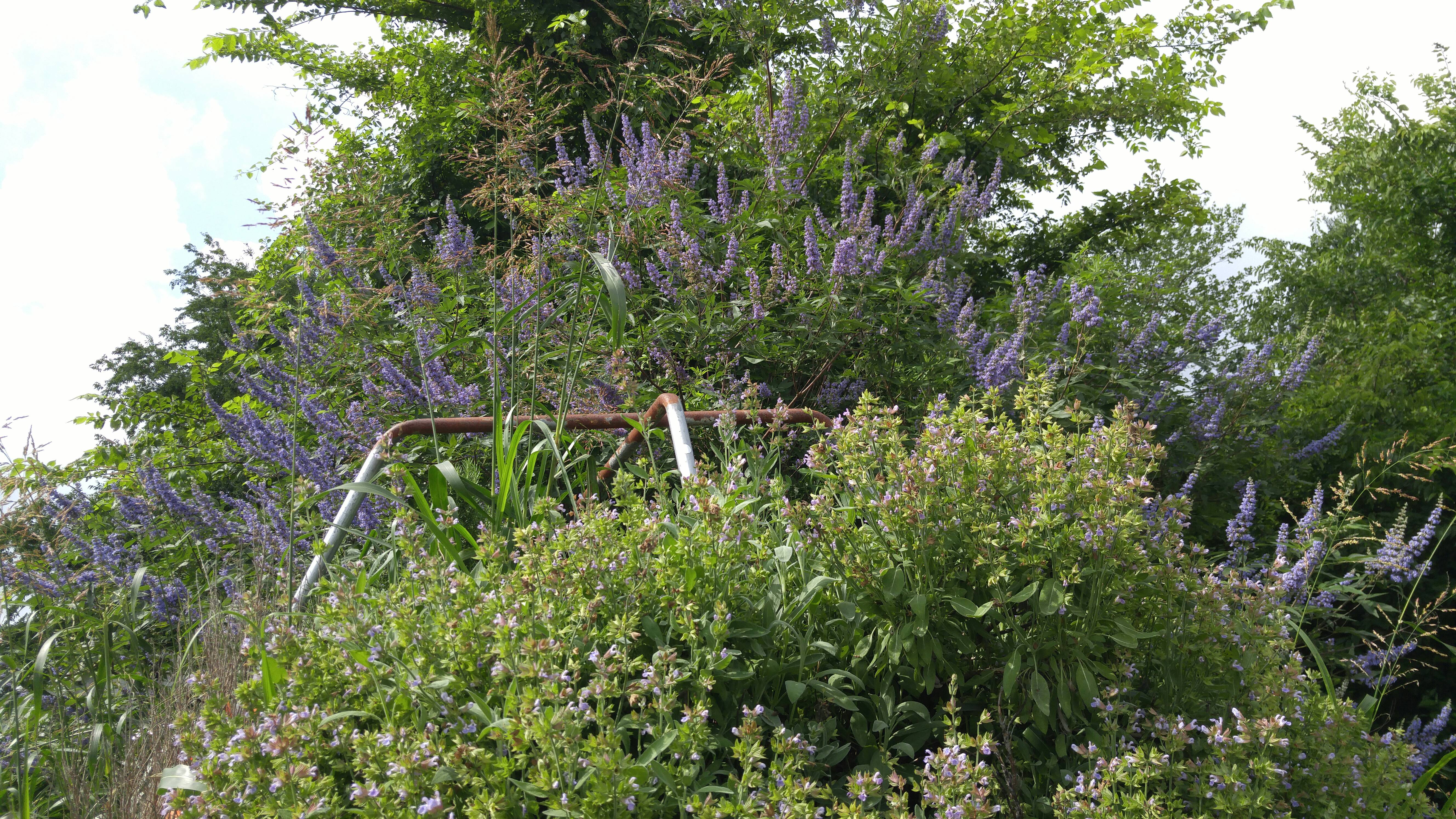 Sage and Texas Lilac |
 Artichokes |
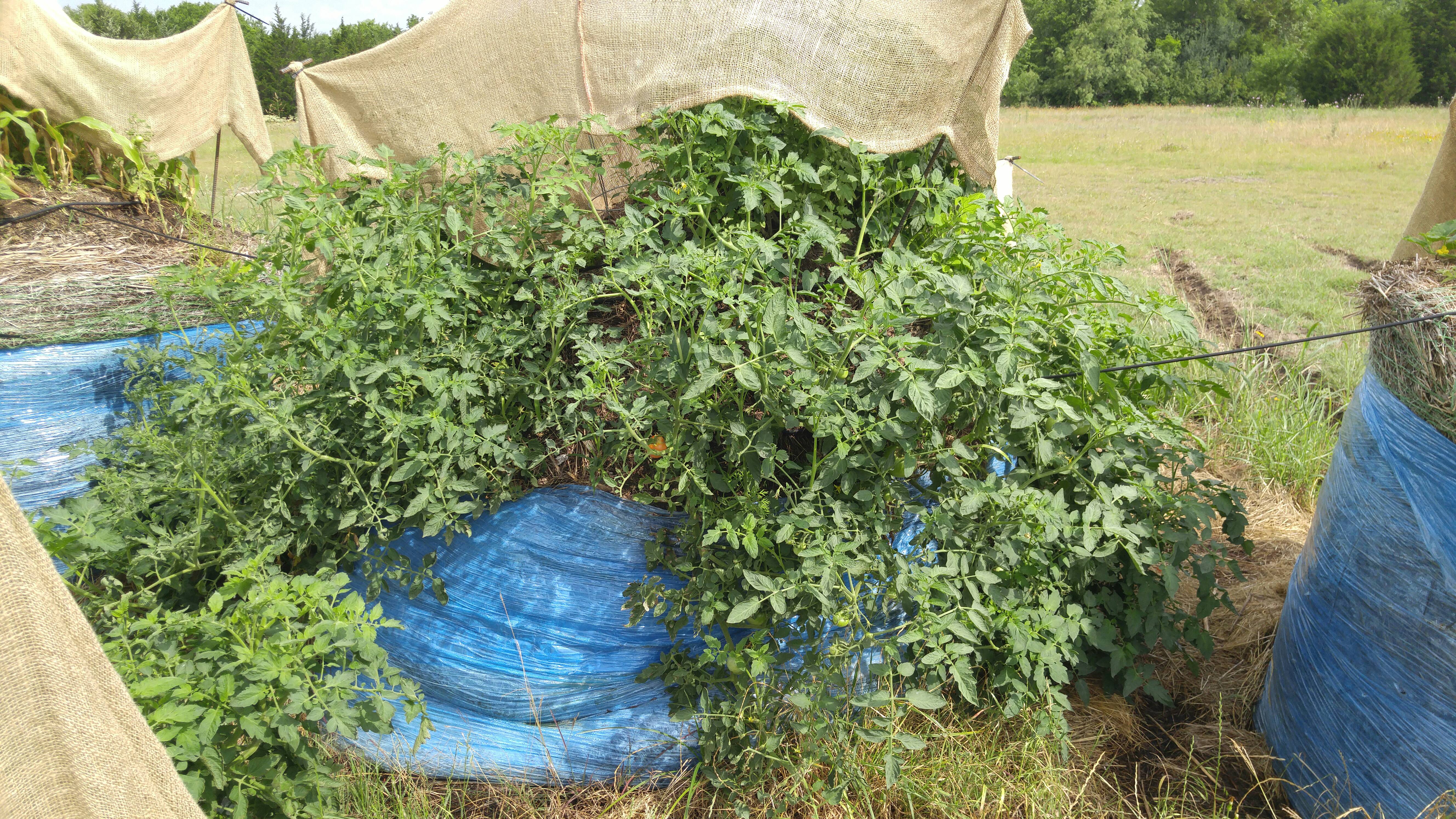 Tomatoes #1 |
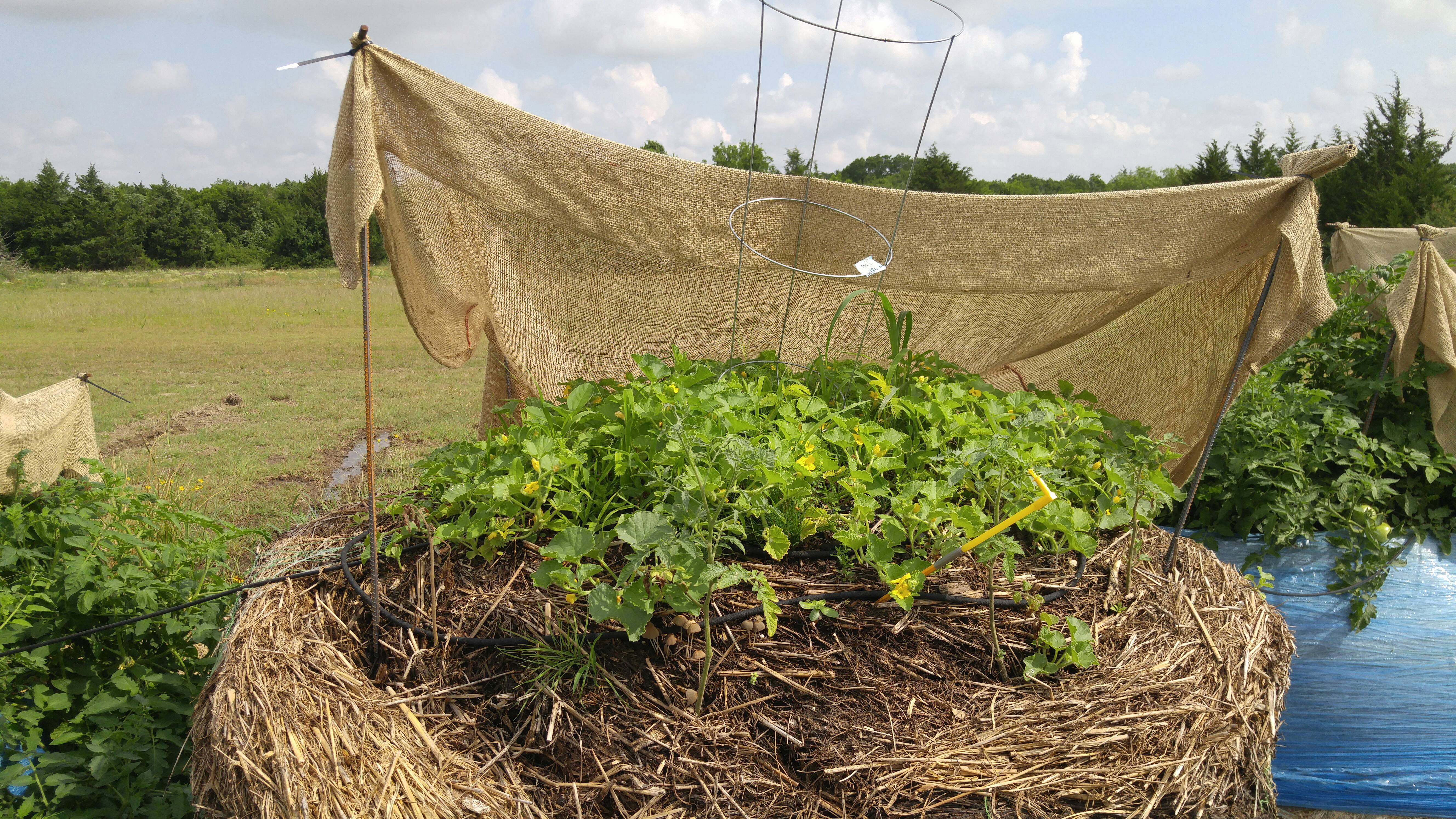 Cantelope |
 Watermelon |
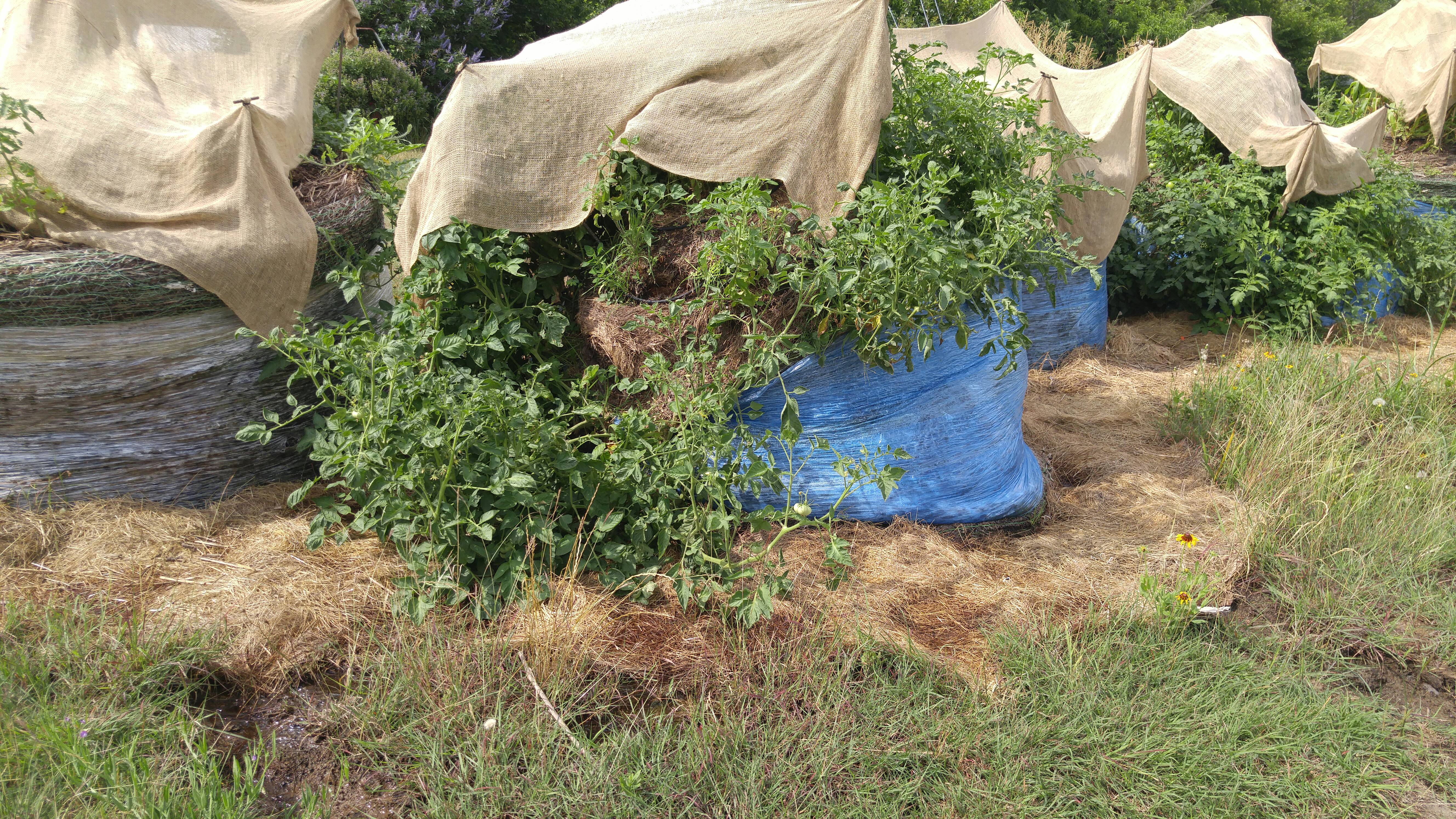 Tomatoes #2 |
 Zinneas Peppers |
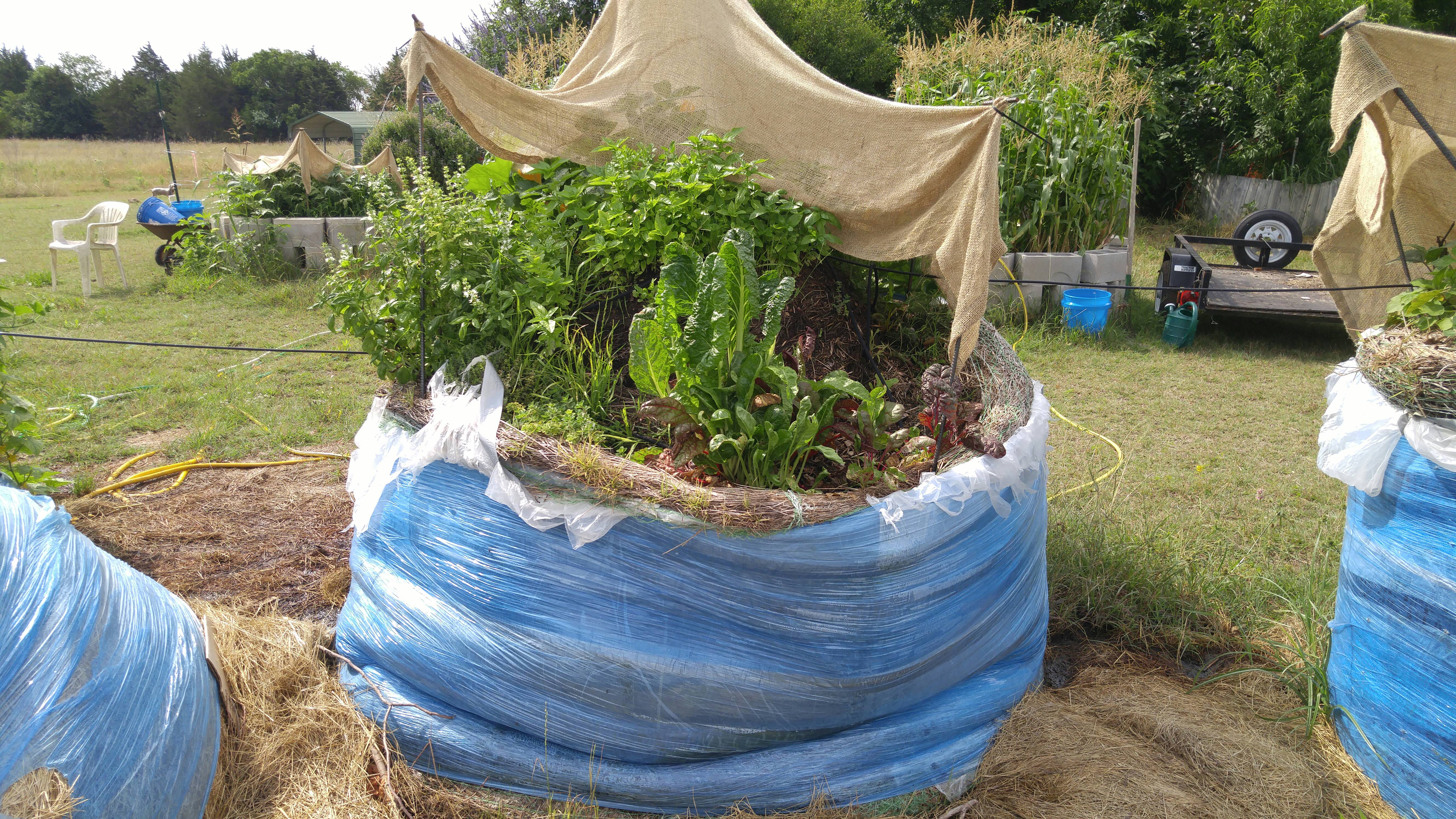 Herbs Swiss Chard |
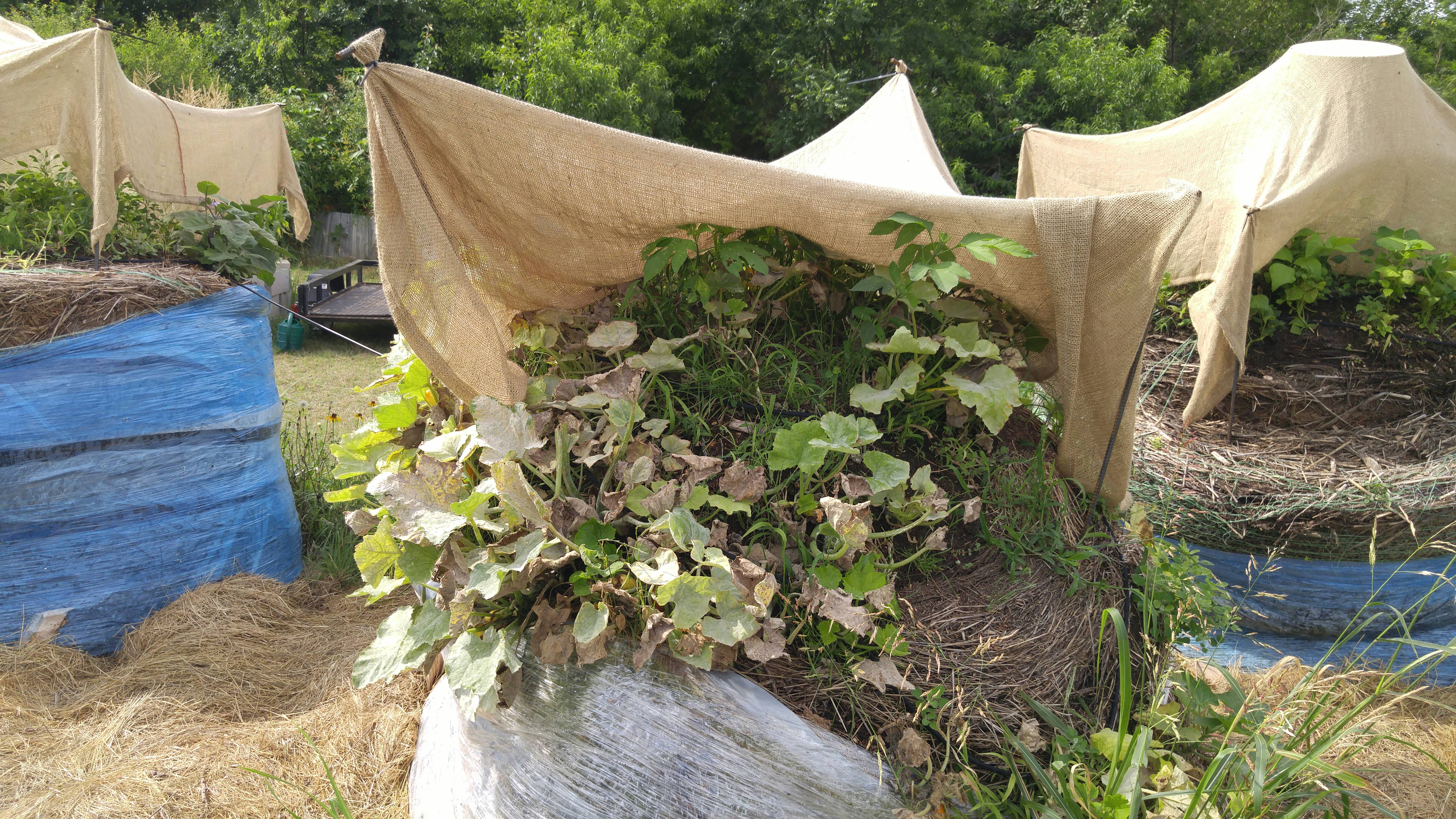 Yellow Squash |
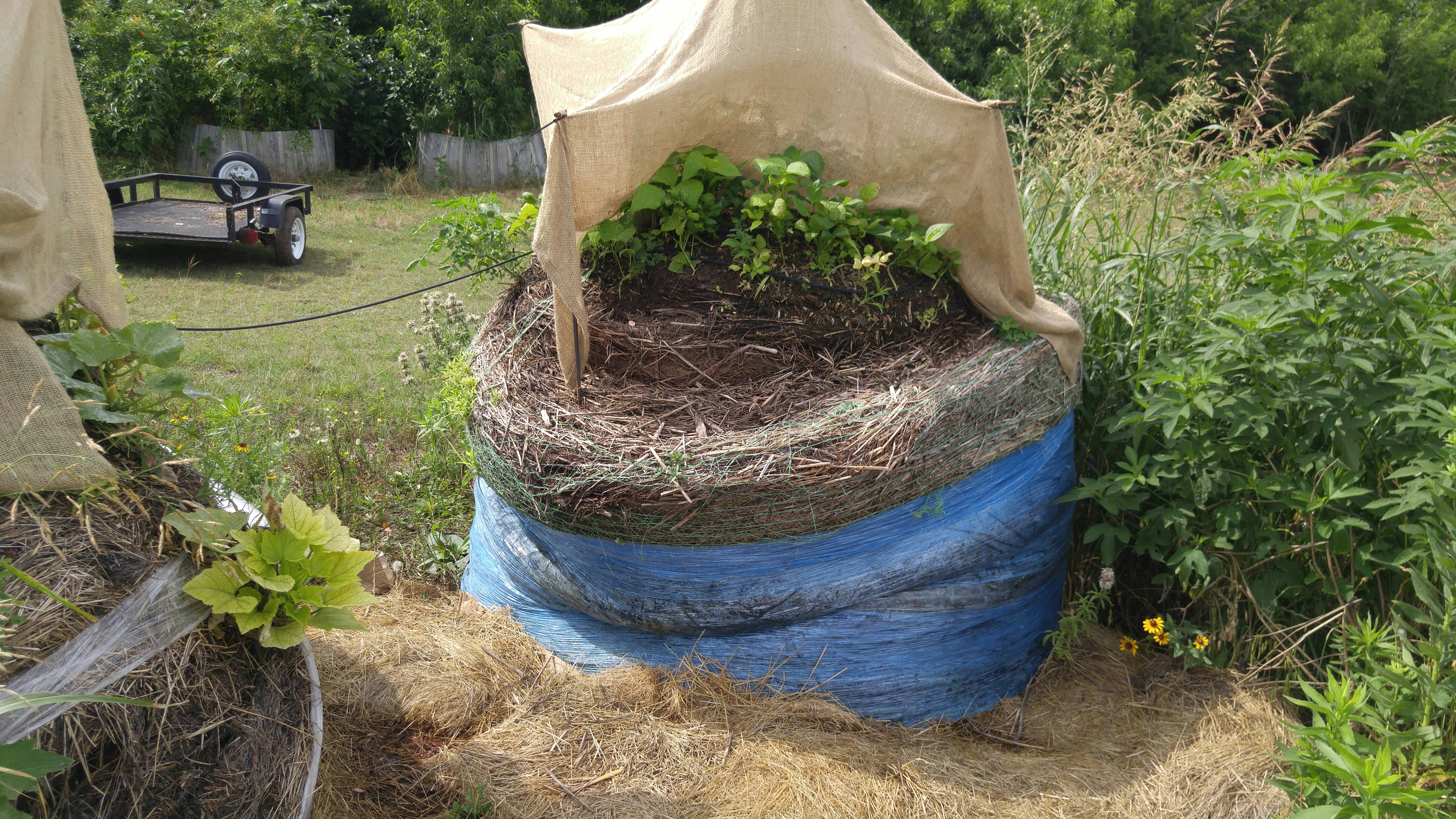 Green Beans |
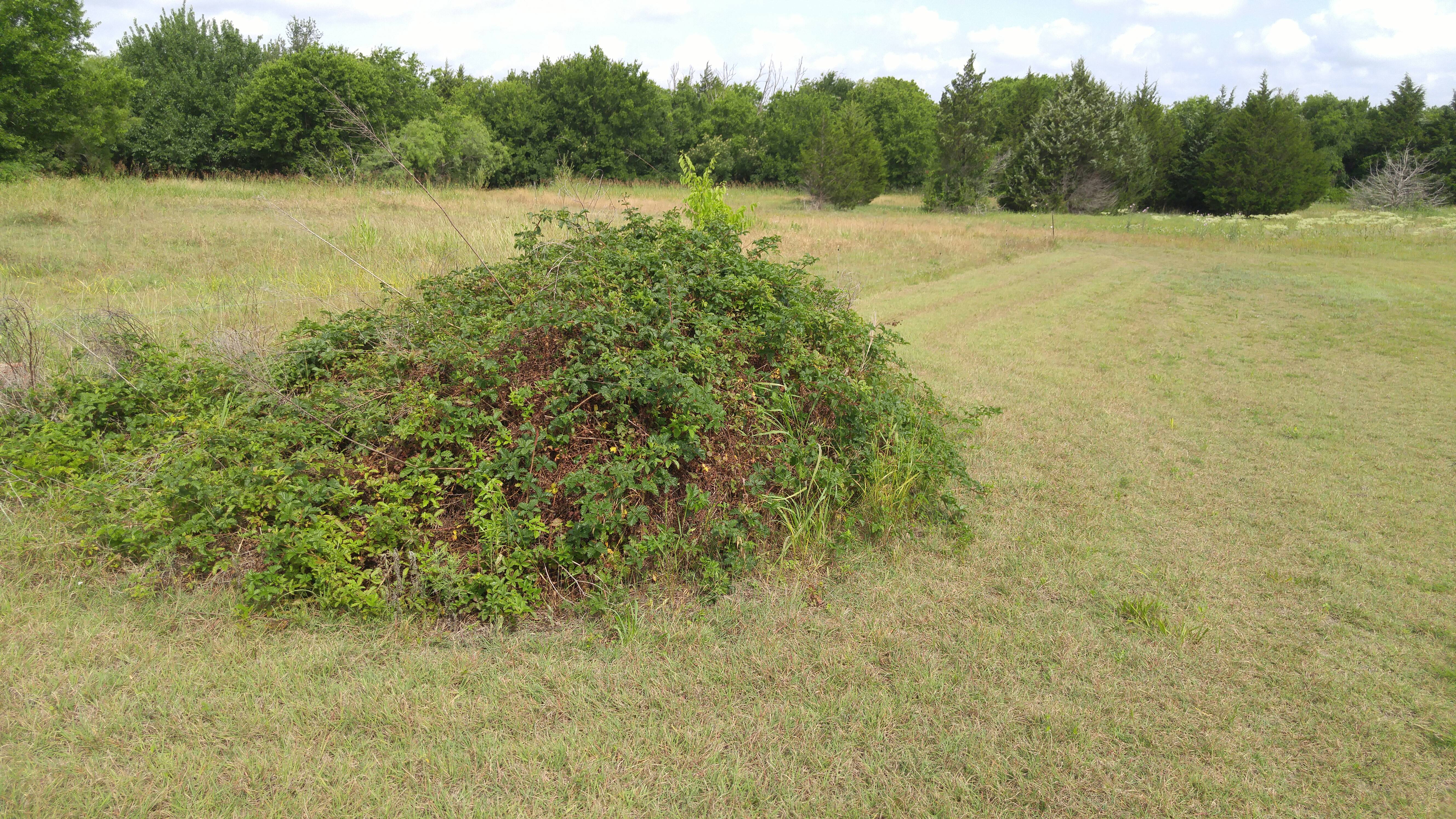 Dewberries |
 Eggplant |
 Zucchini |
 Cucumbers |
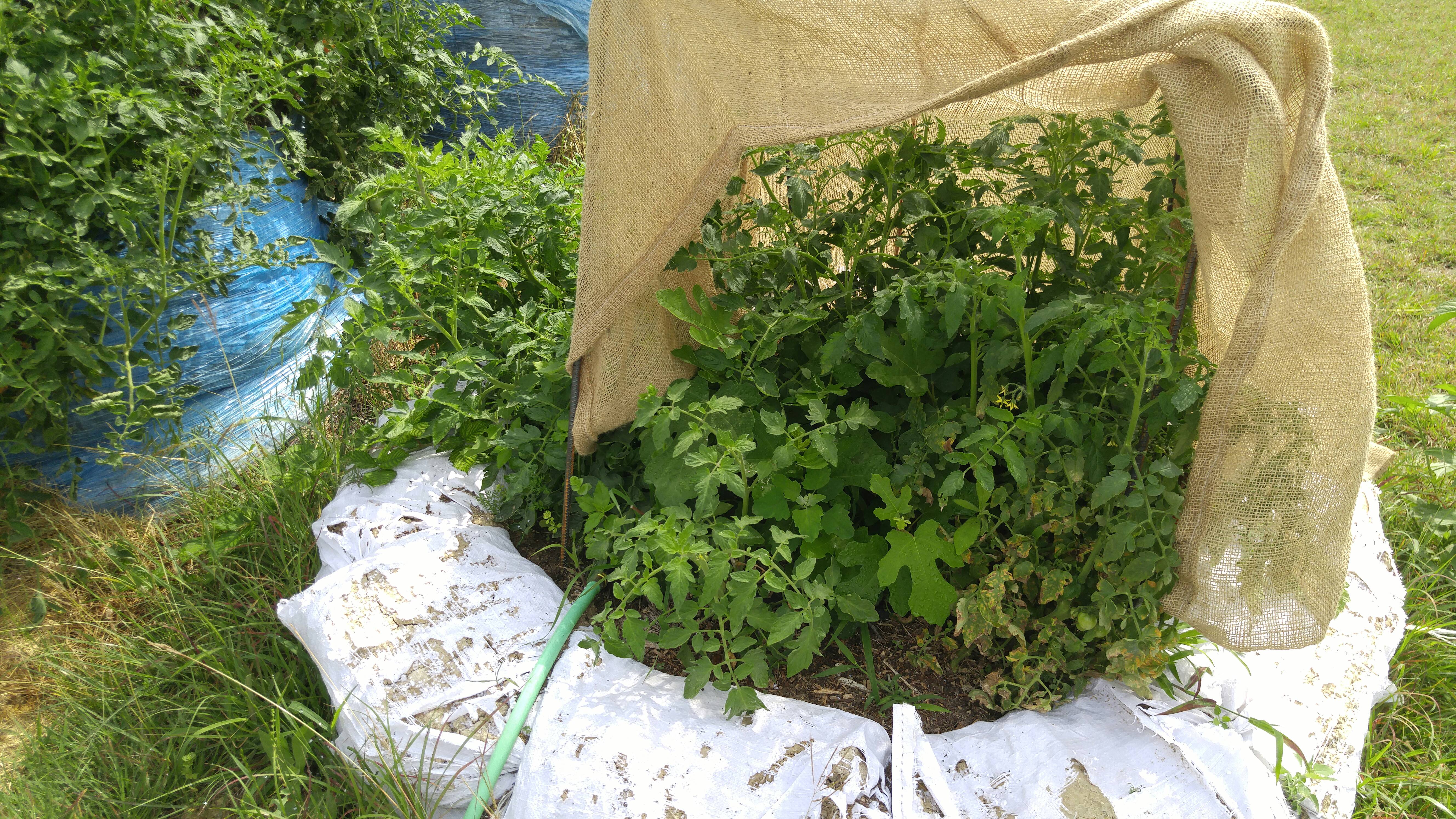 Fig Trees Tomatoes #3 |
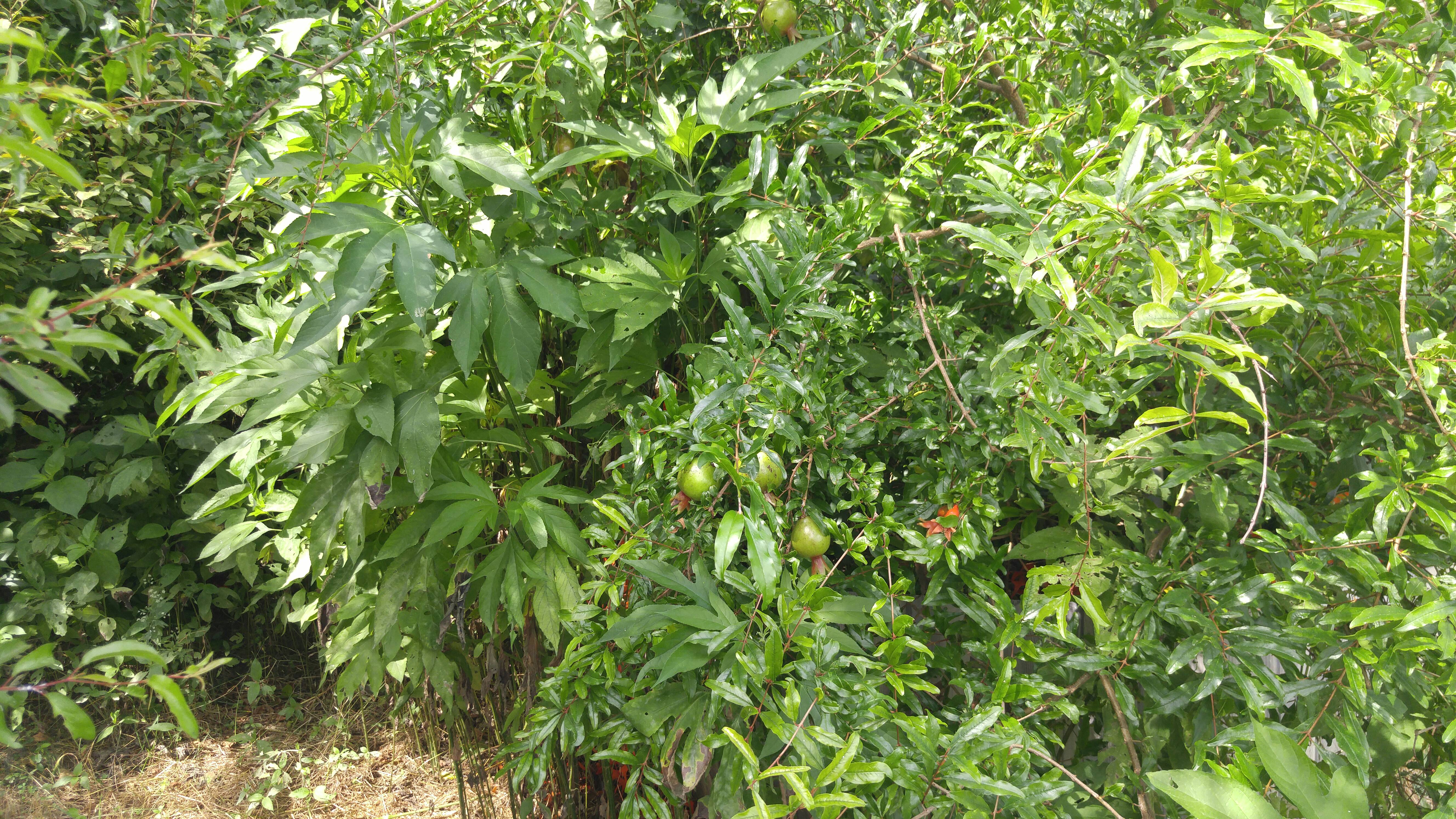 Pomegranates |
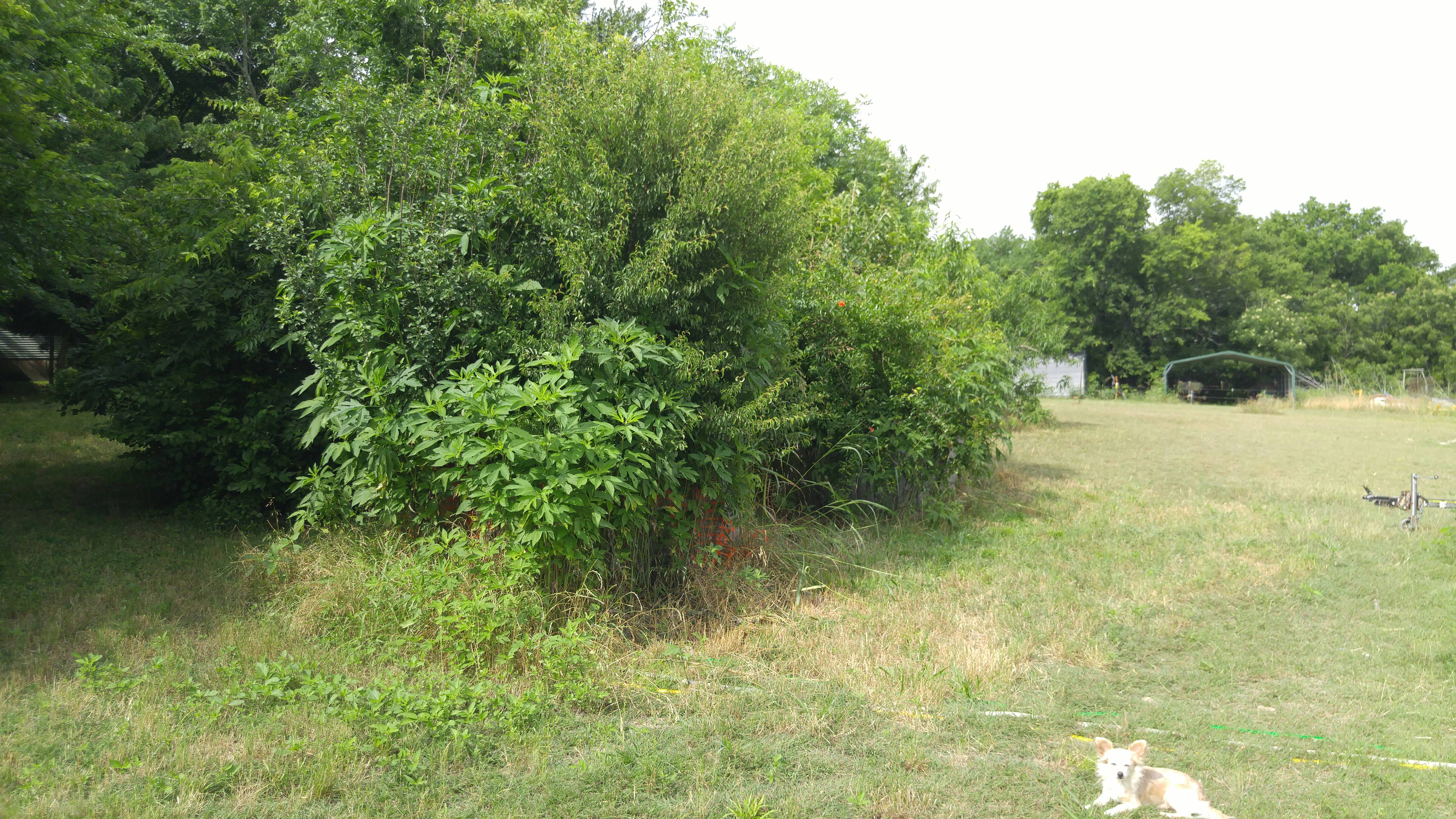 Two Year Old Fruit Trees Planted in Raised Beds |
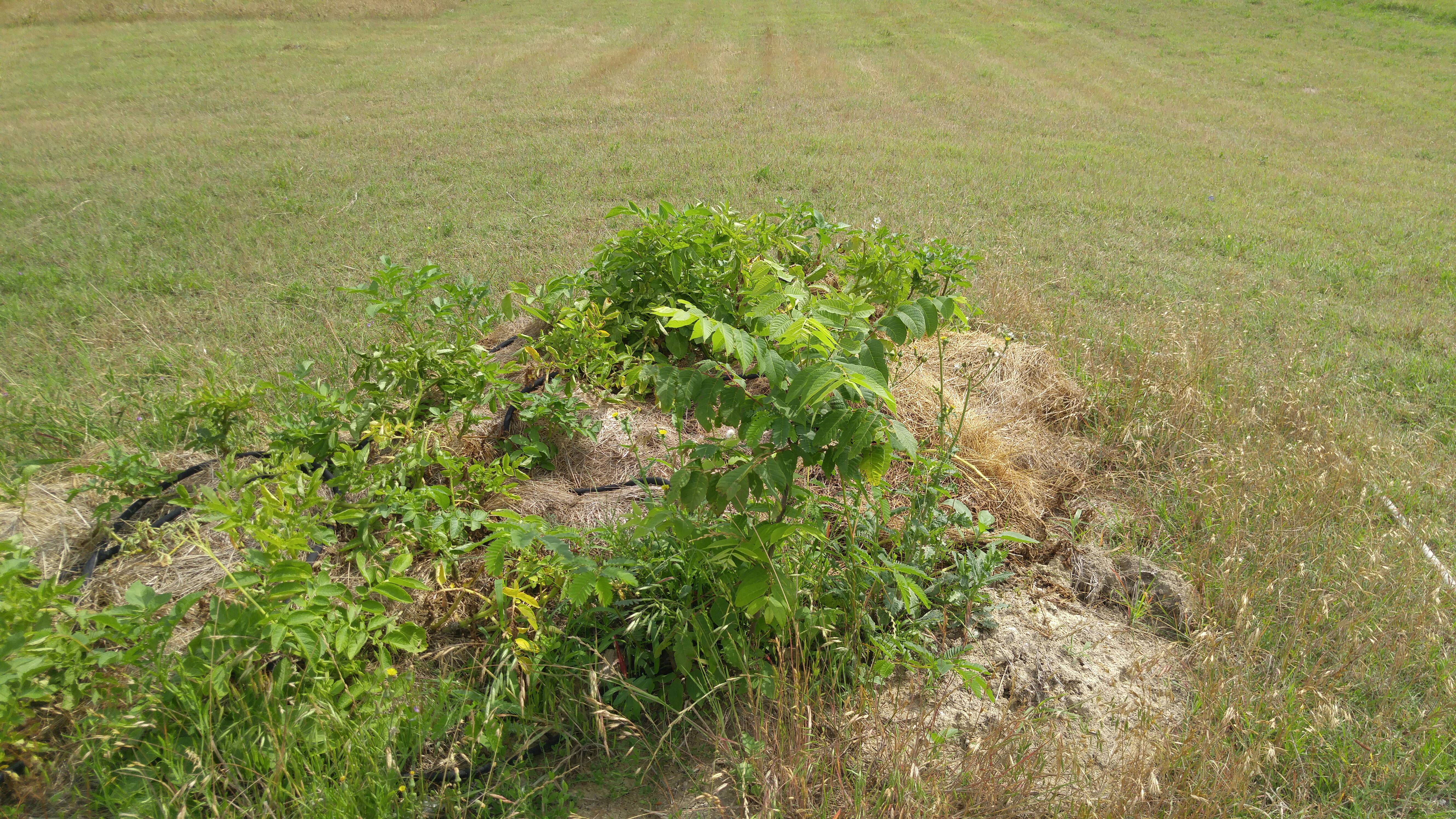 Three Year Old Black Walnut Tree Planted in Soil |
The jury is still out on my 2017 gardening season, but I can definitely attest to the fact that vegetables will grow in round hay bales. Our soil here in north central Texas is very alkaline with little actual topsoil. It's amazing that anything grows, but bluebonnets and many other wild flowers do well. Mustang grapes and dewberries (a thorny vine blackberry) flourish. Plus there are wild plums, cactus, and mesquite pods that are edible.
This looks like my best gardening year ever, using raised "lasagna" or "keyhole garden" beds, cardboard/mulch/hay for potatoes, and the 4 X 6 round hay bales. I also have a small greenhouse that houses the malabar spinach, peppers, and a few winter tomatoes. The main considerations here are:
- Terrible soil
- Wildly variable temperatures . . . it can be 90 or 12 degrees from November to April . . .
- Temperatures can reach to the 100s in May already
- Inconsistant rainfall - floods or droughts are common
These are the conditions one must counter to ever successfully garden here. How do we address these concerns?
- Build your own soil with lasagna gardens, haybale gardens, or a meticulous composting regime.
- You have to be prepared to cover with insulating cloth when it gets cold.
- Then you make shade cloths for when it gets hot.
- Irrigation is required. The good news is that small raised beds do not require as much water as a garden in the ground.
- Finally . . . you plant and grow food whenever and whereever you can. You have to do a fall garden here too. One way is to shade and irrigate enough during the summer so plants come back and produce. The odd thing is that you have to plant seeds in August, when it is hot. Another complication is that nurseries mostly do not provide vegetable garden plants in August. That means I need to learn how to do it. Thus far I have failed miserably in starting plants!
A discussion of each growing method . . .
This potato method has been my most successful to date. We have been pulling out potatoes to eat and give away for a month now. Tricky thing in NC Texas is that once the plants have died, you have to make sure you dig them immediately before they rot. Not like back home where you can leave them in the ground for a long time. To create this garden I first laid down cardboard. Then my husband used the tractor to dump a couple loads of mulch on the cardboard. I placed the already sprouted, cut and dried seed potatoes eye-side-up in the mulch. Finally, covered them with about a foot of hay. Wound a soaker hose through it on top. Gathering the new potatoes is so easy!
I put up my first raised beds about five years ago. Many thanks to Dr. Deb Tolman, http://debtolman.com/ for her videos and inspiration. Originally built them as keyhole gardens placing a cyllinder cage down in the middle. This is a layered bed where you alternate cardboard, mulch, manure, paper, leaves, grass clippings - whatever - and add earth worms. The intention is that you put your table scraps in that center cage and they nourish the garden bed. I never had enough to fill them, so it was an empty cage in the middle. I took them out the second year. It was immediately apparent, however, that I had discovered something that worked! Despite a couple of years of drought and grasshoppers, I was starting to harvest vegetables.
Two years ago I planted fruit trees in three of those raised beds. Plums, pears, peaches, persimmons, and pomegranates. That summer I broke my ankle, so they did not get watered, but still survived. Last year they were small enough that I planted vegetables amongst them. I harvested carrots for the first time and froze 50 quarts of tomatoes. You can see in the pictures how tall these trees are this year and they are starting to produce. Contrast them with the walnut tree I planted 3 years ago in the ground. Pitiful!
This year I added four more raised beds that have rotted logs at the bottom. I layered cardboard, logs, creekbed dirt, cardboard, and mulch on the top. These house the fig trees, artichokes, and corn. I have never managed to get any of these crops to crops to survive in many previous attempts. At this point they all look wonderful. Three of the beds are built with concrete blocks, and one with dirt bags.
I wanted even more raised beds this year, but didn't have the time to build them. Nor did I want to spend that much money. Then a friend of mine sent me an article about hay bale gardening. Wow. These people were using square bales or straw bales. There were many testimonials on YouTube, plus through c99, I got a link from Bisbonian to his partner's blog. This was the best source of information.
* http://thedirtioccupy.blogspot.com/2012/04/dirt-i-occupy-straw-bale-gard...
I went the 4 X 6 round hay bale route because there are so many rotting older round bales in the fields. On the advice of the folks at my favorite farm and garden store, https://www.facebook.com/AthensFarmandGarden/ I just put an ad in the classifieds for older round bales. With delivery and a good price, I ended up with 11 bales.
The most significant difference between the large bales and the smaller square bales is that the larger mass meant much higher temperatures during the conditioning process. To be able to get plants to grow in hay bales, you have to condition them with some sort of nitrogen fertilizer so they start composting. You can use commerical nitrogen fertilizer or urine (also nitrogen fertilizer). Water them every day, but apply nitrogen every other day. Taking the tempertures of the bales with a meat thermometer, some bales were over 185 degrees (the highest my thermometer would go). Large bales will get much hotter and take longer to cool down enough to plant. For square bales you only need to condition them for about 10 days. I put tomato plants in bales before they were cool enough and it burned them. After moving some and putting soil around others, nearly all survived. That was my first mistake. Fortunately the bales cooled down after about another week.
The second mistake I made also involved condidtioning. I bought bales from two different farmers. The first group was only loosely wrapped with cheap plastic or not at all when I began the conditioning. They are the bales that got really hot. For the second group, I shrink wrapped them before I started to apply the nitrogen. It seemed like a good idea because it would hold the moisture in. Right? Wrong. The second group of bales did not compost like the first group. I kept the moisture in, but at the same time kept the oxygen out. Once I finally realized the bales were not composting, I pulled the plastic down a couple of feet and applied more nitrogen to the outer edges. Next time around I will allow more time for conditioning and cooling, and will not shrink wrap the bales until composting is well underway.
I have soaker hoses and timers on everything. Since it is already about 100 degrees in the open sun, I sewed burlap shades for most beds. My husband welded a 3 inch T at the top of 4 ft. rebar. I attached each shade at the corners to four of these rebar stakes with plastic wire ties. It was mid-May before I finished the shades. The benefit was profound. Everything had been burning up in the sun.
This is always the crucial time of year. Will the weather cooperate so I can harvest? The potato and onion crops will be fine. Getting some eggplant, squash and zucchini, and quite a few green beans. However, the cucumbers bloom and bloom yet don't set fruit. I see many little watermelons, but no cantelope. There are small ears of corn. Will they get bigger? Tomatoes?
The advantages of 4X6 round bale gardening are:
- Easy to get started
- You can put them anywhere you have room
- Sustainable (in our area)
- Most plants grow well
- Reshape for additional plantings
In another month or so I will do an update. I welcome advice and suggestions in the comments!


Comments
I love your project.
I think I could incorporate some of your ideas. Shade is something I have never provided except for the portions of the yard where the trees provide it and allow me to keep a few things alive through the hot summer here in south Texas. I may try and set up some shade techniques for next season.
Your'e right, in Texas we have to start our fall garden while it's still hot. Sometimes we can have really hot temps all the way through September and into October.
We had fairly good gardening weather this fall/winter and this spring as well. I'm pretty pleased with our harvests. My biggest problem this year has been the squirrels. They stole every last pomegranate off of our three trees even though the fruit wasn't even remotely close to being ripe.
BTW, I was wondering if you have a problem with snakes in the hay bales?
Trees are the best shade . . .
I have had the best luck to date when either the morning sun, or the afternoon sun is blocked. Glad you have been enjoying your harvests! Thanks for the tip about the squirrels and pomegranates.
Snakes . . . my husband saw a green snake by a bale. One thing I forgot to mention is that water pools around the bottom of the bales. Husband dug little trenches going downhill from each bale which helps. It otherwise doesn't seem like I am over-watering.
Marilyn
"Make dirt, not war." eyo
I see what you did there
All kidding aside, that looks great. Going to reread this a couple of times. Good stuff, Marilyn. Wasn't expecting the fruit trees, amazing.
You have thin topsoil like I do. Perfect remedy.
Thanks for a great essay. Looking forward to the updates. Especially interested in your fall season preparations.
Neither Russia nor China is our enemy.
Neither Iran nor Venezuela are threatening America.
Cuba is a dead horse, stop beating it.
You could even put a bale
in a parking lot!
Marilyn
"Make dirt, not war." eyo
Bernie's favorability rating is still climbing
Results look great.
Poor soil takes a while to overcome. This is a great alternative and it appears in addition to a crop there is compost available to spread around after you are done with the bales.
Still yourself, deep water can absorb many disturbances with minimal reaction.
--When the opening appears release yourself.
Seems I remember you saying hay is a local
crop . . . that's one reason why you focus on animals. Maybe a hay bale with insulating cloth for cold temps?
Marilyn
"Make dirt, not war." eyo
Great post, thanks!
I tried a strawbale gardening experiment a while back but with mixed results, I may revisit that at some point.
In clay alkaline soils I've had great success with greens, especially kale, and oddly, pear trees.
"Obama promised transparency, but Assange is the one who brought it."
I researched videos on straw bale gardening
years ago and decided not to try it. Seems like then folks were just putting potatoes in bales and expecting something to happen. Conditioning/composting the bales was the new thing I noticed this time.
On parts of our property we have black clay. It is so hard it is impossible to work with. Do you do something special to condition your clay soil?
I have two pear trees in my raised beds, so I am hoping!
Marilyn
"Make dirt, not war." eyo
The composting/conditioning aspect
likely works because it's hay and not straw that you're working with. Straw takes a long time to compost. Mine probably would have worked better with some nutrients added, and a drainage system like the one you described above.
At first I thought I would condition the soil, now I realize that it's an open-ended, continuous battle as the compost and nutrients slowly disappear into the clay. No matter how many amendments you add, or in what proportion, the soil will always be heavy clay at best.
My strategy now is growing what is adapted to the soil, in the soil, and then using raised beds and my old garden plot for the rest. Raised beds of some sort (ie hay bales qualify) I think are definitely the way to go, it's much easier to manage the soil years hence.
By the way, there's nothing like a ripe pear, straight off the tree. Apples didn't do well in my soil, but cherries do ok, I've got them too.
"Obama promised transparency, but Assange is the one who brought it."
Try mixing sand with your clay soil
Make sure it is washed sand or it has no salt in it. And as Marilyn has noted before, urine will add nitrogen and acid to counter the alkalinity.
Local gardening supply would have a urea supplement also.
Some veggies need really good drainage, like onions. I add sand and it works well.
Neither Russia nor China is our enemy.
Neither Iran nor Venezuela are threatening America.
Cuba is a dead horse, stop beating it.
Doesn't sand make it concrete? n/t
"Obama promised transparency, but Assange is the one who brought it."
No, you need cement for that.
For clay soils add lots of organic material and sand to create a sandy loam that will drain water. Use sand sparingly as it cannot be removed, only diluted with more organic material.
Neither Russia nor China is our enemy.
Neither Iran nor Venezuela are threatening America.
Cuba is a dead horse, stop beating it.
I have an endless supply of
urine. Teenage son thinks it is cool to supply this via old milk jugs. Hope he never sees this! But it is so wonderful.
Marilyn
"Make dirt, not war." eyo
HI Marilyn, how about a tag "resilience" or however that's
done? What a great project. My pictures at the top of your post are having some trouble loading (terrible internet speeds) but I'm hoping to see them all.
We are finally getting what we think of as our last house, and we are not sure of the soils. But this is something for the files.
Is it your experience that the layering/spaghetti type soil-making is faster than the compost? I tend to just dump things and wait. But that can take years. Great stuff if there's room and time, not so great if a garden needs a real start, quickly.
Thanks for sharing.
You may choose to look the other way, but you can never say again you did not know. ~ William Wiberforce
If you can donate, please! POP Money is available for bank-to-bank transfers. Email JtC to make a monthly donation.
Oh yes . . . it is much faster . . .
You create the layers, put a bit of potting soil on top and plant. I recommend you watch Dr. Deb Tolman videos on the subject. It is composting underneath as the plants grow on top. She is a scientist and has a formula you follow. I am not quite that careful, but basically alternate brown biodegradables (like cardboard) with green biodegradables (grass clippings, manure). Everything is really wet as you build = soaked cardboard. Earthworms, or red worms(?) top it all off.
And the bales . . . condition for a couple of weeks . . . much faster.
I don't know how to do the resilience tag. When I have tried in the past it has not worked. ???
Best wishes with your last house.
Marilyn
"Make dirt, not war." eyo
Wow, that's some intensive, compressive resilience going on.
What a dizzying array of crops!
Thanks for putting this together, Marilyn. As a city/suburban dweller all my life I don't have the first clue about any of this, but deeply appreciate and am fascinated with those who do.
We have a small community garden space that we haven't had time to do much of, aside from recently pulling up the weeds and clearing the bed a couple of weeks ago. Don't know how we'll be able to get anything under way at this rate and this late into the season.
On a related note, saw a very depressing story here or somewhere about farming in India almost completely having been reduced, due to aggro corporate domination, to just four crops, with two being soybeans and sugar cane (sugar?). As far as I'm concerned, along withe the Economic Terrorists of Wall St, global corporate monopolies are the biggest evil in the world, and are completely intertwined.
It's heartbreaking and angering to me how farmers have always seemed to be targeted by the banks and corporations. Capitalism in its relentless pursuit of profit is destroying the planet and humanity. I'd love to see a Farmer's Holiday Movement again, to rise up in solidarity across this country (and world) to stare down these bastards, like these guys did making up the many farmer's revolts throughout the Midwest in the 1930's.
"Rebellion In the Corn Belt: American Farmers Beat Their Plowshares into Swords,” by Mary Heaton Vorse, December 1932 issue of Harper’s Magazine.
These stories charge me up. There's a spirit out there just the same that we have yet to uncover, I think...
Looking at your photos I keep wondering, how do you water all this (seems like a mammoth project, the whole thing)?
Impressive and hopeful. Thanks again.
"If I should ever die, God forbid, let this be my epitaph:
THE ONLY PROOF HE NEEDED
FOR THE EXISTENCE OF GOD
WAS MUSIC"
- Kurt Vonnegut
Thanks for that Mark
The spark that lights the comming uprising may very well come from rural America. I feel law enforcement in the heartland will be the first to turn on the status quo and join with their neighbors and family in resistance.
We can only hope.
Neither Russia nor China is our enemy.
Neither Iran nor Venezuela are threatening America.
Cuba is a dead horse, stop beating it.
Thank you - National Farmers Union
Thank you so much for the history lesson! It seems like my mom's siblings belonged to the National Farmer's Union in NE South Dakota. I don't think my dad did however, although he was from a family of activists it seems like he objected to the union telling you what to do - 30 years later from these accounts.
There certainly needs to be a small farmer's union now. One of John Oliver's most fabulous segments about chicken farmers illustrates why.
[video:https://youtu.be/X9wHzt6gBgI]
Aeroponic towers may be an urban solution . . .
[video:https://youtu.be/p7DFUQNrvjo]
I plan to experiment with aeroponics as well.
Marilyn
"Make dirt, not war." eyo